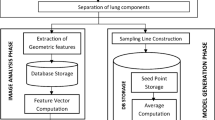Abstract
The lung image segmentation using a model-based approach is a challenge owing to the sheer complexity and variability of the lung shape in a given data set. As a part of our effort to segment the lungs, we report a method to delineate the costophrenic (CP) recess without the human intervention. Active shape model (ASM) is used to point to the probable area of the CP recess, and a prior knowledge-based processing delineates the CP recess and hence determines the angle. The proposed method is fast and shows satisfactory results. It is intended to be used as a preprocessing step in segmenting the lungs’ contour. The proposed method also can be used to initialize the model contour in any other ASM-based lung segmentation algorithms. The algorithm was tested on 45 non-nodule lung images from the JSRT database. An average accuracy of 87.02% is achieved. A comparison of the results of proposed method and gold standard which is obtained by manual delineation is given.
Access this chapter
Tax calculation will be finalised at checkout
Purchases are for personal use only
Similar content being viewed by others
References
Cootes, T., Taylor, C., Cooper, D., & Graham, J. (1995). Active shape models—their training and application. Computer Vision and Image Understanding, 61, 38–59.
Tsai, A., Yezzi, A., Wells III, W. M., Tempany, C. M., Tucker, D., Fan, A., et al. (2003). A shape-based approach to the segmentation of medical imagery using level sets. IEEE Transactions on Medical Imaging, 22(2), 137–54. PMID: 12715991.
Paragios, N. & Deriche, R. (1998). Geodesic active regions for texture segmentation. INRIA, Sophia Antipolis, France, Res. Rep. 3440.
Shi, Y., Q, F., Xue, Z., Chen, L., Ito, K., Matsuo, H., & Shen, D. (2008). Segmenting lung fields in serial chest radiographs using both population-based and patient-specific shape statistics. IEEE Transactions on Medical Imaging, 27(4), 481–494./ https://doi.org/10.1109/tmi.2007.908130.
Maduskar, P., Philipsen, R. H., Melendez, J., Scholten, E., Chanda, D., Ayles, H., et al. (2016). Automatic detection of pleural effusion in chest radiographs. Medical Image Analysis, 28, 22–32. https://doi.org/10.1016/j.media.2015.09.004. Epub 2015 December 1.
Wan Ahmad, W. S. H. M., & Ahmad Fauzi, M. F., & Zaki, W. (2015). Abnormality detection for infection and fluid cases in chest radiograph (pp. 62–67). https://doi.org/10.1109/elecsym.2015.7380815.
Campadelli, P., & Casiraghi, E. (2005). Lung field segmentation in digital postero-anterior chest radiographs. In S. Singh, M. Singh, C. Apte, & P. Perner (Eds.), Pattern recognition and image analysis (vol. 3687, pp. 736–745). Lecture Notes in Computer Science. Springer, Heidelberg, Germany.
Abi-Nahed, J., Jolly, M. P., & Yang, G. Z. (2006). Robust active shape models: a robust, generic and simple automatic segmentation tool. In R. Larsen, M. Nielsen, J. Sporring (Eds.), Medical Image Computing and Computer-Assisted Intervention—MICCAI.
De la Torre, F., & Black, M. J. (2003). A framework for robust subspace learning. International Journal of Computer Vision, 54(1–3), 117–142.
Behiels, G., Maes, F., Vandermeulen, D., & Suetens, P. (2002). Evaluation of image features and search strategies for segmentation of bone structures in radiographs using active shape models. Medical Image Analysis, 6(1), 47–62.
Shiraishi, J., Katsuragawa, S., Ikezoe, J., Matsumoto, T., Kobayashi T., Komatsu, K., et al. (2000). Development of a digital image database for chest radiographs with and without a lung nodule: Receiver operating characteristic analysis of radiologists’ detection of pulmonary nodules. AJR 174, 71–74.
van Ginneken, B., Stegmann, M. B. & Loog, M. (2006). Segmentation of anatomical structures in chest radiographs using supervised methods: A comparative study on a public database. Medical Image Analysis, 10(1), 19–40.
Author information
Authors and Affiliations
Corresponding author
Editor information
Editors and Affiliations
Rights and permissions
Copyright information
© 2019 Springer Nature Singapore Pte Ltd.
About this paper
Cite this paper
Athavale, P.A., Puttaswamy, P.S. (2019). Automated Delineation of Costophrenic Recesses on Chest Radiographs. In: Shetty, N., Patnaik, L., Nagaraj, H., Hamsavath, P., Nalini, N. (eds) Emerging Research in Computing, Information, Communication and Applications. Advances in Intelligent Systems and Computing, vol 906. Springer, Singapore. https://doi.org/10.1007/978-981-13-6001-5_7
Download citation
DOI: https://doi.org/10.1007/978-981-13-6001-5_7
Published:
Publisher Name: Springer, Singapore
Print ISBN: 978-981-13-6000-8
Online ISBN: 978-981-13-6001-5
eBook Packages: EngineeringEngineering (R0)




